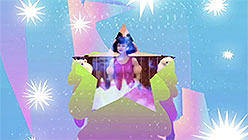ATA’s 6th Annual Film and Video Festival is tightly curated into two programs, City Symphonies and Slingshot. Allow us to interpret. If your night is going to begin with prosecco and end with port, you might want to head to program 1. If you’re more likely to end up throwing empty cans of PBR off an overpass, program 2 is for you. With live music and sound, and coming in at around an hour run time each, they’re equally tempting back-to-back. These are some of our favorites.
Featured in the first program is an enigmatic short from Tunisian filmmaker Nadia Rais. L’Ambouba is an animated 35mm film, and the large format allows for some of the most lushly layered animation imaginable. The story follows a cartoonishly obese woman in a transparent dress. The folds of her breasts and body knead into each other and spill across the frame as she grazes the tips of her pointed heels across the floor. When the woman looks out the window of a city bus, massive apartment buildings are being built and raised in rapid succession, propelled by the swell of North African drums. The majority of the film is covered in the soft and loose sketchiness of pastel and charcoal, but the architectural backdrop is sparingly rotoscoped with the clarity of a real photograph.

Nadia Rais, L’Ambouba, 2009.
Equally hypnotic, if studious, is Alexandra Cuestra’s Piensa en Mi. This film also spends time looking through bus windows — only these windows are marred with graffiti and the grime of years of public service. The setting is Los Angeles, and the camera sits trained on the unsmiling faces of people in transit. The sound is subtle and brilliantly wrought by masking familiar bus noises: no one talks to each other, and there’s no music or announcements. The film borrows a title from Agustín Lara’s bolero, which includes gentlemanly rebuking lines as “when you feel like crying, think of me.” After a long meditation, sheltered in the confines of transit, the camera finally lands in a public park. Dust blows by with the sounds of an ice cream cart, majestic as a temple’s bells.




